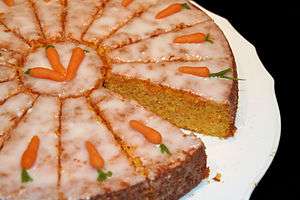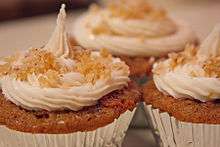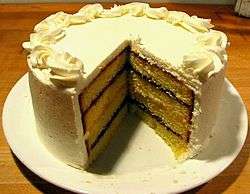Carrot cake
 | |
| Type | Loaf, sheet cake |
|---|---|
| Main ingredients | Flour, eggs, sugar, carrots, almonds and baking powder[1] |
| Variations | Hazelnuts, lemon, kirsch, cinnamon[1] |
|
| |
Carrot cake is a cake that contains carrots mixed into the batter. The carrot softens in the cooking process, and the cake usually has a soft, dense texture.[2]
Baking and ingredients
Carrot cake closely resembles a quick bread in method of preparation (all the wet ingredients, such as the eggs and sugar, are mixed, all the dry ingredients are mixed, and the wet are then added to the dry) and final consistency (which is usually denser than a traditional cake and has a coarser crumb).
Many carrot cake recipes include other ingredients, such as kirsch, cinnamon, nuts, pineapple or raisins. The most common icing on carrot cake is icing sugar and lemon juice or icing sugar and kirsch (Europe) and an icing with icing sugar, butter and cream cheese (United States).
As the cake is relatively moist, it can be conserved longer than many other types of cakes.
Presentation
Carrot cake may be eaten plain, but it is commonly either glazed or topped with white icing or cream cheese icing and walnuts, usually chopped. It is often coated with icing or marzipan made to look like carrots. Carrot cake is popular in loaf, sheet cake and cupcake forms, and (in the United Kingdom, as well as North America) can be found pre-packaged at grocery stores, and fresh at bakeries. Some carrot cakes are even layered.
History
Carrots have been used in sweet cakes since the medieval period, during which time sweeteners were scarce and expensive, while carrots, which contain more sugar than any other vegetable besides the sugar beet, were much easier to come by and were used to make sweet desserts. The origins of carrot cake are disputed. Recipes for carrot cake occur as early as 1827, in a French cookbook published in England.[3] Another 19th century recipe comes from the housekeeping school of Kaiseraugst (Canton of Aargau, Switzerland).[4] According to the Culinary Heritage of Switzerland, it is one of the most popular cakes in Switzerland, especially for the birthdays of children.[4]
The popularity of carrot cake was probably revived in Great Britain because of rationing during the Second World War.[5] Carrot cakes first became commonly available in restaurants and cafeterias in the United States in the early 1960s. They were at first a novelty item, but people liked them so much that carrot cake became standard dessert fare. In 2005, the American-based television channel Food Network listed carrot cake, with its cream-cheese icing, as number five of the top five fad foods of the 1970s. Carrot cake was voted as the favourite cake in the United Kingdom, according to a survey in the Radio Times in 2011.
Another story indicates that following the Second World War there was a glut of canned carrots in the United States. A business man named George C. Page hired master bakers to find uses for the cans of carrots. He somehow promoted the idea of carrot cake to help create a demand for the product.
See also
- Chai tow kway – a fried "carrot cake" commonly found in Southeast Asia as a breakfast or snack item; however the name "carrot cake" is a misnomer. It contains no carrot, but actually white daikon radish because Asians often refer to carrots as "red daikon" due to the similar shapes of the respective roots.
- List of carrot dishes
Notes and references
- 1 2 (German) Aargauer Rübelitorte, www.kulinarischeserbe.ch (page visited on 31 July 2014).
- ↑ L.V. Anderson. "You're Doing It Wrong: Carrot Cake". Slate. Retrieved 2013-11-14.
- ↑ Antoine B. Beauvilliers, The Art of French Cookery … , 3rd ed. (London, England: Longman, 1827), page 227.
- 1 2 (French) Véronique Zbinden "Patrimoine culiraire suisse (9/14). Rueblitorte, gâteau végétal et fédéral", Le Temps, Thursday 31 July 2014, page 10.
- ↑ Lynne Olver. "Cake History Notes". The Food Timeline. Retrieved 2012-01-01.
Bibliography
- Alton Brown, I'm Just Here for More Food: Food × Mixing + Heat = Baking, New York: Stewart, Tabori & Chang, 2002 (ISBN 1-58479-341-4).
- Alan Davidson, Oxford Companion to Food, second edition, illustrations by Soun Vannithone, London: Oxford University Press, 2006 (ISBN 0-19-280681-5).

